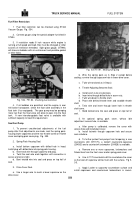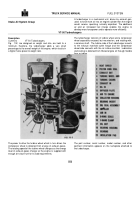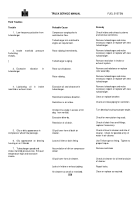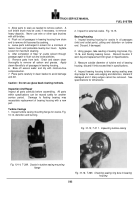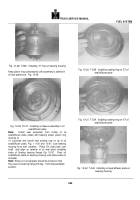TM-5-3805-254-14-P-2 - Page 561 of 894
TRUCK SERVICE MANUAL
FUEL SYSTEM
Note:
It Is Important that line to manometer be size and
length as given to minimize variation in reading due to a
standing wave phenomenon which occurs in a manometer
line.
A change in length of material of this line can significantly
change reading obtained.
Maintenance
Compressor wheel and compressor housing must be kept
clean for best turbocharger performance.
Any buildup of dirt
or soil sludge on compressor wheel will substantially reduce
compressor efficiency, increase rotor imbalance and reduce
intake manifold air pressure.
This may ultimately lead to a
failure.
Possibility of mechanical failure and loss of
performance demands periodic inspections.
Under normal operating conditions, turbocharger is subject to
very little wear since rotor is only moving part.
Rotor must be
accurately balanced due to its high rotative speed and
extremely close running clearances.
It is very important that
this balance not be disturbed and that running clearances be
maintained
Operate engine at rated output, and listen for
unusual turbocharger noise.
If a shrill whine (over and above
normal turbine whine) is heard, shut down immediately.
Whine is indicative
of
Imminent
turbocharger
bearing
failure.
Remove turbocharger ,for overhaul.
Other unusual noises
would result from improper clearance between turbine wheel
and turbine housing.
If such noises are head, turbocharger
must
be
removed
from
the
engine, disassembled, and
inspected.
Service Periods
1.
Clean turbocharger compressor wheel as listed in
Maintenance Section.
a.
Remove air Intake to turbocharger connection, air
inlet piping to turbocharger and compressor casing to expose
compressor wheel.
Use Bendix cleaner, or a similar type
solvent, and a bristle brush to clean carbon from compressor
wheel and compressor casing.
Caution:
Never use a caustic solution that may attach
aluminum.
Such solution may either weaken parts or
destroy their balance.
Also, never use a wire brush
scraper or abrasive air jet to clean compressor wheel.
b.
Dry unit carefully and reassemble compressor casing
to bearing housing.
Torque "V" band clamp nuts to proper
torque specifications.
See Specifications.
c.
Reconnect air piping and secure with clamps.
d.
Check compressor wheel for oil sludge build-up.
Determine cause and correct such items as undersized oil
bath air cleaner, air restriction, over-filling oil cup, etc.
2.
Check bearing clearance as described under "Rotor
End Clearance" In Maintenance Section.
Major Cleaning Operation
When it is evident that major cleaning operation is necessary
to remove heavy carbon deposits, remove turbocharger from
the engine and disassemble, clean, Inspect, repair or replace
and reassemble as described in Rebuild Instructions.
Rotor End Clearance
Check end clearance as listed in Maintenance Section.
This can be done without removing turbocharger from
engine by using a dial indicator to indicate end clearance
of rotor shaft.
Checking Procedure
1.
Remove exhaust outlet connection and Intake piping
from turbocharger to expose both ends of rotor assembly.
2.
Attach a dial indicator to compressor casing.
Push
shaft as far as possible to rear.
Register indicator point
against
end of rotor shaft and zero indicator, push shaft from
rear toward indicator point and note indicator
reading.
It
cannot exceed
limits listed
in
Dimensions
and
Specifications.
3.
If end clearance is not within limits, turbocharger
should be removed from the engine and replaced by a new or
rebuilt unit.
556
Back to Top





